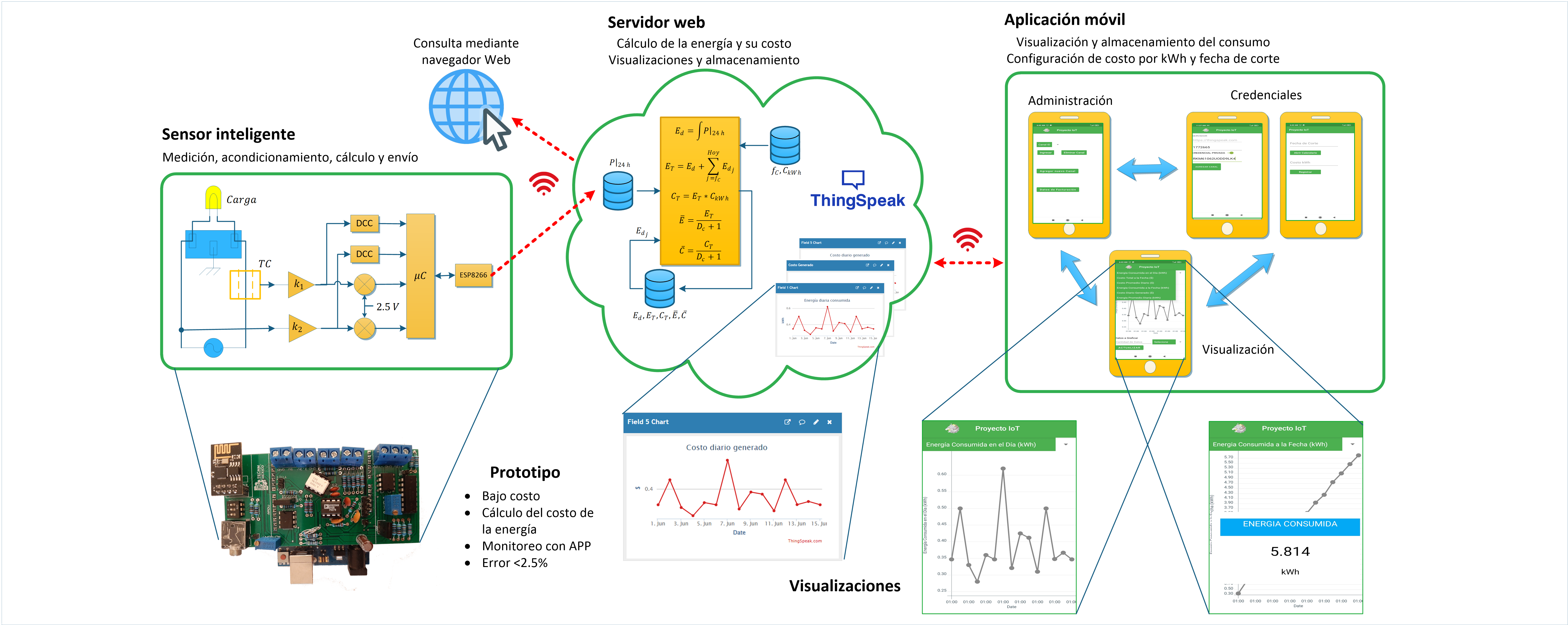Electrical energy consumption monitoring system in the residential sector using IoT
Keywords:
Electrical energy consumption, Monitoring system, Internet of Things, Mobile application.Abstract
In Latin America and the Caribbean, the consumption of energy, that comes mainly from fossil resources, have carried an increase in the air pollution. Electricity generation and its consumption in residential sector contributes to this problem with a significant percentage. On the other hand, recent research has demonstrated that the use of smart energy meters in developed countries reduces the electricity consumption due the continuous feedback gave to the consumer. This research presents the developing and implementation of an electrical energy consumption monitoring system based on smart sensors with IoT technology. The system calculates the instant power and the electrical efficiency as well as the energy consumed and its cost. The information of these variables is processed and transferred trough a WIFI ESP8266 module to a ThingSpeak server that works like a cloud database. Also, an Android mobile application that interacts directly with the database was developed to users visualize the variables behavior. For validate the smart sensor accuracy its measures were compared with the measures of an oscilloscope and a multimeter. Relative errors between -2.34 and 1.92 % were observed.
Downloads
References
Statistics Division of the Economic Commission for Latin America and the Caribbean (ECLAC), “Energy in Latin America and the Caribbean: access, renewability and efficiency,” no. 5, May. 2022. [Online]. Available: https://repositorio.cepal.org/bitstream/handle/11362/47925/1/S2200272_en.pdf
M. Koengkan, J. A. Fuinhas, N. Silva, “Exploring the capacity of renewable energy consumption to reduce outdoor air pollution death rate in Latin America and the Caribbean region,” Environ. Sci. Pollut. Res., vol. 28, no. 2, pp. 1656-1674, Jan. 2021, doi: 10.1007/s11356-020-10503-x
R. Jimenez, A. Yépez-Garcia, “Energy for Households: Summary and Recommendations,” in How do households consume energy?: evidence from Latin American and Caribbean, IDB Publications (Books) Inter-American Development Bank, 2020, pp. 10-15. [Online]. Available: https://publications.iadb.org/publications/english/document/How-Do-Households-Consume-Energy-Evidence-from-Latin-American-and-Caribbean-Countries.pdf
K. Chooruang and K. Meekul, "Design of an IoT Energy Monitoring System," 2018 16th International Conference on ICT and Knowledge Engineering (ICT&KE), 2018, pp. 1-4, doi: 10.1109/ICTKE.2018.8612412.
E. Aydin, D. Brounen, N. Kok, “Information provision and energy consumption: Evidence from a field experiment,” Energy Econ., vol. 71, pp. 403-410, Mar. 2018, doi: 10.1016/j.eneco.2018.03.008.
J. D. C. Restrepo, T. Morales-Pinzón, T, “Effects of feedback information on the household consumption of water and electricity: a case study in Colombia,” J. Environ. Manage., vol. 262, p. 110315, May. 2020, doi: 10.1016/j.jenvman.2020.110315.
A. Nilsson, M. Wester, D. Lazarevic, N. Brandt, “Smart homes, home energy management systems and real-time feedback: Lessons for influencing household energy consumption from a Swedish field study,” Energy Build., vol. 179, pp. 15-25, Nov. 2018, doi: 10.1016/j.enbuild.2018.08.026
V. Tiefenbeck, A. Wörner, S. Schöb, E. Fleisch, T. Staake, “Real-time feedback promotes energy conservation in the absence of volunteer selection bias and monetary incentives,” Nat. Energy, vol. 4, no. 1, pp. 35-41, Jan. 2019, doi: 10.1038/s41560-018-0282-1
R. Krishnamurthi, A. Kumar, D. Gopinathan, A. Nayyar, and B. Qureshi, “An Overview of IoT Sensor Data Processing, Fusion, and Analysis Techniques,” Sensors, vol. 20, no. 21, p. 6076, Oct. 2020, doi: 10.3390/s20216076.
J. Leitão, P. Gil, B. Ribeiro and A. Cardoso, “A Survey on Home Energy Management,” IEEE Access, vol. 8, pp. 5699-5722, Jan. 2020, doi: 10.1109/ACCESS.2019.2963502.
I. Dupont, R. Pereira, S. Juca and P. Carvalho, “Internet of Things Data Acquisition System Applied to Photovoltaic Water Pumping,” IEEE Lat. Am. Trans., vol. 16, no. 10, pp. 2547-2560, Oct. 2018, doi: 10.1109/TLA.2018.8795134.
N. Ali Hussien, A. A. Daleh Al-Magsoosi, H. T. S. AlRikabi, and F. Theyab Abed, “Monitoring the Consumption of Electrical Energy Based on the Internet of Things Applications”, Int. J. Interact. Mob. Technol., vol. 15, no. 07, pp. pp. 17–29, Apr. 2021, doi: 10.3991/ijim.v15i07.20183.
S. Muralidhara, N. Hegde, P. M. Rekha, “An internet of things-based smart energy meter for monitoring device-level consumption of energy,” Comput. Electr. Eng., vol. 87, p. 106772, Oct. 2020, doi: 10.1016/j.compeleceng.2020.106772.
M. D. Mudaliar, N. Sivakumar, “IoT based real time energy monitoring system using Raspberry Pi,” Internet of Things, vol. 12, p. 100292, Dec. 2020, doi: 10.1016/j.iot.2020.100292.
M. Tastan, “Internet of things based smart energy management for smart home,” KSII Trans. Internet Inf. Syst., vol. 13, no. 6, pp. 2781-2798, Jun. 2019, doi: 10.3837/tiis.2019.06.001.
AVAGO TECHNOLOGIES, “HCPL-7800A/HCPL-7800 Insolation Amplifier datasheet,” 2008. [Online]. Available: https://www.mouser.com/datasheet/2/678/V02-0410EN-908738.pdf.
R. Wall, “A Report on the properties of the Yhdc Current Transformer and its suitability for use with the OpenEnergy monitor,” Issue 6, Mar. 18, 2014. [Online]. Available: https://learn.openenergymonitor.org/electricity-monitoring/ct-sensors/files/YhdcCTReportIss6.pdf
M. Asadpourahmadchali, M. Niasati, Y. Alinejad‐Beromi, “Hybrid continuous circuit‐trapezoidal integration method analysis of multi‐cross structure of grounding system,” IET Sci. Meas. Technol., vol. 14, no. 3, pp. 292-302, May 2020, doi: 10.1049/iet-smt.2019.0050.
CFE Comisión Federal de Electricidad, “Esquema tarifario vigente-Hogar,” 2022. [Online]. Available: https://app.cfe.mx/Aplicaciones/CCFE/Tarifas/TarifasCRECasa/Casa.aspx


